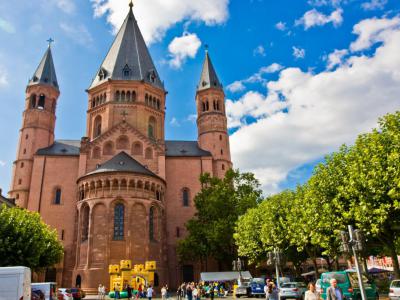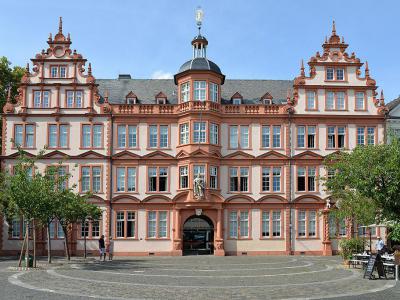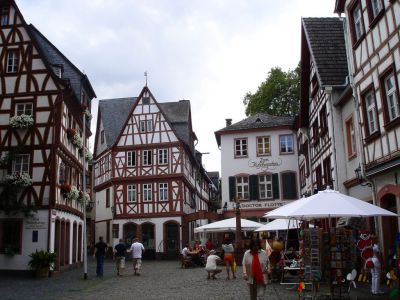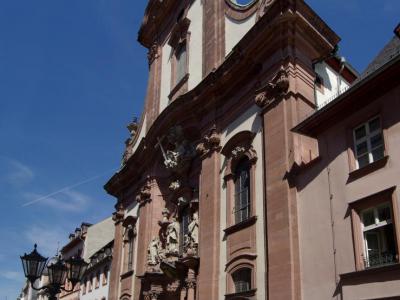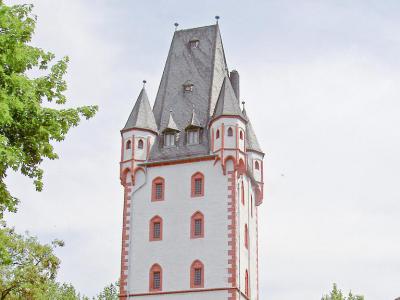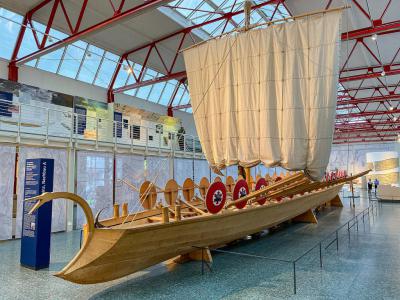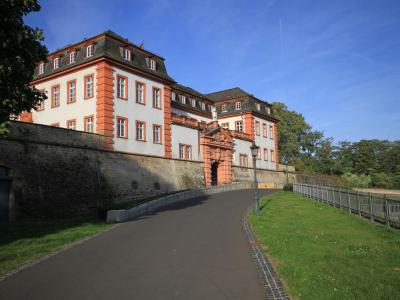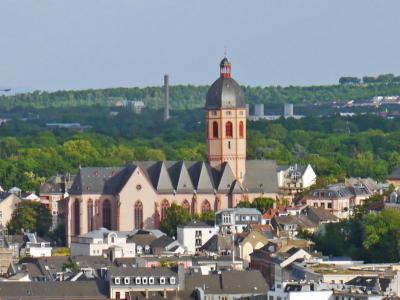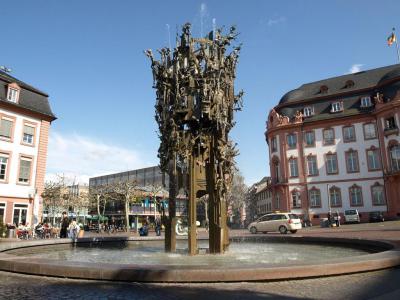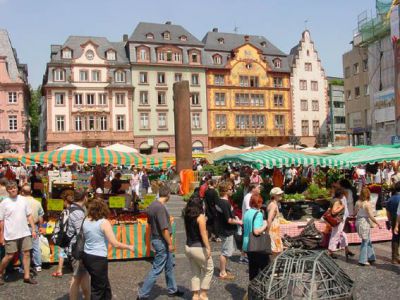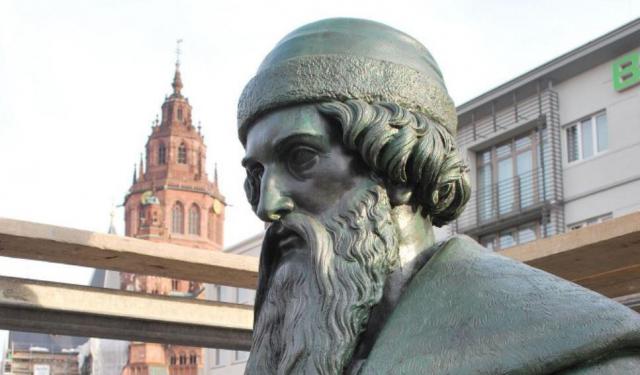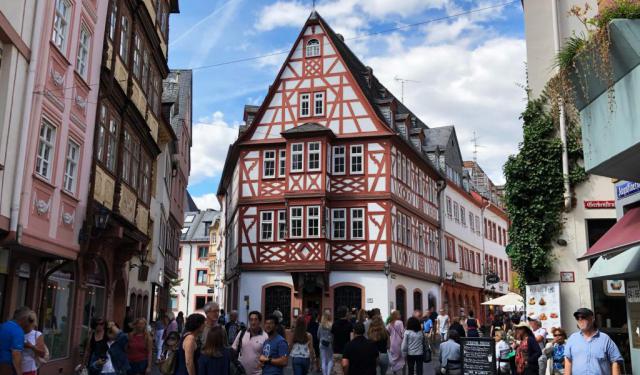
Mainz Introduction Walking Tour (Self Guided), Mainz
Mainz is the Rhineland-Palatinate state capital and its largest city. It is located on the Rhine river, where the Main river joins the Rhine. Mainz has remained a prosperous city and is an important container port hub.
Mainz was founded as a Roman military fortress in the 1st century BC. The Roman stronghold was called Mogontiacum. Visitors can see several Roman shipwrecks and learn more about Roman military ships at the Museum of Ancient Shipbuilding.
During the 8th century AD, Mainz became a vital part of the Holy Roman Empire. Mainz was an important center for early Christianity, and the Mainz Cathedral is over 1,000 years old. St. Stephen’s Church is the area’s oldest Gothic hall church.
Mainz's location on the Rhine and in the center of the Holy Roman Empire made it a vital port and city. It became part of the Grand Duchy of Hesse, which wanted more fortifications for this strategic location. Visitors can see the Wooden Tower, which was built in the 15th century as part of the city’s walls. The Citadel is another vital part of the city’s fortifications and dates to the 1600s.
French and Prussian troops occupied Mainz in the 1790s. Napoleon Bonaparte’s French army occupied Mainz and claimed it for France until they were defeated in 1814. Mainz was a neutral zone during the Austro-Prussian War in 1866 and became part of the German Empire in 1871.
The National Socialist (Nazi) Party established a base in Mainz in the 1930s, and Mainz suffered significant damage from World War II bombs.
Visitors can travel back in time by visiting the Cherry Orchard. This historic square features classic half-timbered homes, one of which dates to the 1500s. Market Square is home to some of the city’s oldest and most important buildings and has hosted markets for over a thousand years.
Johannes Gutenberg, the famous printing press inventor, was born in Mainz and printed the famous Gutenberg Bible in Mainz in 1450. Mainz has several monuments and landmarks dedicated to its most influential citizen. Visitors can learn more about Gutenberg’s life, see an original Gutenberg Bible, and view a recreated printing press at the Gutenberg Museum.
Take this self-guided tour to explore the most notable sights of Mainz.
Mainz was founded as a Roman military fortress in the 1st century BC. The Roman stronghold was called Mogontiacum. Visitors can see several Roman shipwrecks and learn more about Roman military ships at the Museum of Ancient Shipbuilding.
During the 8th century AD, Mainz became a vital part of the Holy Roman Empire. Mainz was an important center for early Christianity, and the Mainz Cathedral is over 1,000 years old. St. Stephen’s Church is the area’s oldest Gothic hall church.
Mainz's location on the Rhine and in the center of the Holy Roman Empire made it a vital port and city. It became part of the Grand Duchy of Hesse, which wanted more fortifications for this strategic location. Visitors can see the Wooden Tower, which was built in the 15th century as part of the city’s walls. The Citadel is another vital part of the city’s fortifications and dates to the 1600s.
French and Prussian troops occupied Mainz in the 1790s. Napoleon Bonaparte’s French army occupied Mainz and claimed it for France until they were defeated in 1814. Mainz was a neutral zone during the Austro-Prussian War in 1866 and became part of the German Empire in 1871.
The National Socialist (Nazi) Party established a base in Mainz in the 1930s, and Mainz suffered significant damage from World War II bombs.
Visitors can travel back in time by visiting the Cherry Orchard. This historic square features classic half-timbered homes, one of which dates to the 1500s. Market Square is home to some of the city’s oldest and most important buildings and has hosted markets for over a thousand years.
Johannes Gutenberg, the famous printing press inventor, was born in Mainz and printed the famous Gutenberg Bible in Mainz in 1450. Mainz has several monuments and landmarks dedicated to its most influential citizen. Visitors can learn more about Gutenberg’s life, see an original Gutenberg Bible, and view a recreated printing press at the Gutenberg Museum.
Take this self-guided tour to explore the most notable sights of Mainz.
How it works: Download the app "GPSmyCity: Walks in 1K+ Cities" from Apple App Store or Google Play Store to your mobile phone or tablet. The app turns your mobile device into a personal tour guide and its built-in GPS navigation functions guide you from one tour stop to next. The app works offline, so no data plan is needed when traveling abroad.
Mainz Introduction Walking Tour Map
Guide Name: Mainz Introduction Walking Tour
Guide Location: Germany » Mainz (See other walking tours in Mainz)
Guide Type: Self-guided Walking Tour (Sightseeing)
# of Attractions: 10
Tour Duration: 2 Hour(s)
Travel Distance: 3.3 Km or 2.1 Miles
Author: ellen
Sight(s) Featured in This Guide:
Guide Location: Germany » Mainz (See other walking tours in Mainz)
Guide Type: Self-guided Walking Tour (Sightseeing)
# of Attractions: 10
Tour Duration: 2 Hour(s)
Travel Distance: 3.3 Km or 2.1 Miles
Author: ellen
Sight(s) Featured in This Guide:
- Mainz Cathedral
- Gutenberg Museum
- Kirschgarten (Cherry Orchard)
- Augustinerkirche (St. Augustine's Church)
- Holzturm (Wood Tower)
- Museum of Ancient Shipbuilding
- Zitadelle (Citadel)
- St. Stephen's Church
- Schiller Square
- Markt (Market Square)
1) Mainz Cathedral (must see)
Mainz has been a center of Christianity since 746 when venerated Saint Boniface brought Christianity to the area. Archbishop Willigis ordered a new cathedral and modeled it on Rome's famous St. Peter's. Mainz Cathedral suffered extensive damage from a fire on the day of its inauguration in 1009. It was repaired by 1036.
Mainz Cathedral retains the original Romanesque style, while chapels and other additions have been added over the centuries and reflect each time period's style.
Mainz Cathedral's triple nave Romanesque pillar basilica and the bronze door facing the square are original. The cathedral has several side chapels and is surrounded by other buildings. St. Gotthard's chapel was built in 1137 and features lighter colored stone.
Fire damaged the cathedral seven times over the centuries. The spire was built in 1767 from stone to protect it from future fire damage.
The east chancel is the oldest part of the cathedral, and the walls there are over two meters (six and a half feet) thick. The Romanesque west chancel dates to 1239, and its Gothic belfry was added in the 15th century.
The cathedral houses tombs and remains of many of the cathedral's bishops. Mainz Cathedral's portrait gallery is one of its most beloved treasures. The portrait gallery features centuries of ecclesiastical dignitaries.
Several kings and queens of Germany were crowned in Mainz Cathedral in the 11th, 12th, and 13th centuries. The Diet of Pentecost was held in the cathedral and is known as one of the most legendary feasts of the Middle Ages.
Mainz was attacked by French troops in 1792 and Prussian troops in 1793. The cathedral was damaged and then used as barracks. Many of the church's artifacts were sold, and parts of the wooden interior were burned for heat. The cathedral was restored to a church in 1814, and reconstruction work was completed in 1831.
The Rhine river correction damaged Mainz Cathedral's foundations in the early 1900s. The cathedral was reinforced with concrete and steel. World War II bombs damaged the cathedral, and restoration work continued into the 1970s.
Despite of the damages, there is a good number of art works can be seen inside the cathedral. In the Ketteler chapel, visitors will find an altar to the Virgin Mary. The Ketteler chapel features a statue of the "Serene Lady of Mainz." The wood-carved figures date to 1510.
Today Mainz Cathedral is an iconic symbol of the city.
Mainz Cathedral retains the original Romanesque style, while chapels and other additions have been added over the centuries and reflect each time period's style.
Mainz Cathedral's triple nave Romanesque pillar basilica and the bronze door facing the square are original. The cathedral has several side chapels and is surrounded by other buildings. St. Gotthard's chapel was built in 1137 and features lighter colored stone.
Fire damaged the cathedral seven times over the centuries. The spire was built in 1767 from stone to protect it from future fire damage.
The east chancel is the oldest part of the cathedral, and the walls there are over two meters (six and a half feet) thick. The Romanesque west chancel dates to 1239, and its Gothic belfry was added in the 15th century.
The cathedral houses tombs and remains of many of the cathedral's bishops. Mainz Cathedral's portrait gallery is one of its most beloved treasures. The portrait gallery features centuries of ecclesiastical dignitaries.
Several kings and queens of Germany were crowned in Mainz Cathedral in the 11th, 12th, and 13th centuries. The Diet of Pentecost was held in the cathedral and is known as one of the most legendary feasts of the Middle Ages.
Mainz was attacked by French troops in 1792 and Prussian troops in 1793. The cathedral was damaged and then used as barracks. Many of the church's artifacts were sold, and parts of the wooden interior were burned for heat. The cathedral was restored to a church in 1814, and reconstruction work was completed in 1831.
The Rhine river correction damaged Mainz Cathedral's foundations in the early 1900s. The cathedral was reinforced with concrete and steel. World War II bombs damaged the cathedral, and restoration work continued into the 1970s.
Despite of the damages, there is a good number of art works can be seen inside the cathedral. In the Ketteler chapel, visitors will find an altar to the Virgin Mary. The Ketteler chapel features a statue of the "Serene Lady of Mainz." The wood-carved figures date to 1510.
Today Mainz Cathedral is an iconic symbol of the city.
2) Gutenberg Museum (must see)
The Gutenberg Museum is dedicated to Johannes Gutenberg, one of Mainz's most famous residents. Gutenberg is known as the "Man of the Millenium" for creating a printing press with movable metal type. Gutenberg's printing press revolutionized the world. The museum also exhibits international printing presses and scripts.
Audio guides are available in English, French, and German, and guided tours are available. Guests can start their visit by watching a short film about Gutenberg's life and work.
The Gutenberg Museum has two priceless copies of the famous original 42-line Gutenberg Bible, printed around 1450. In addition, visitors can see a recreation of Gutenberg's workshop, including a demonstration of how a 15th-century printing press operated.
Additional exhibits include printing presses, typesetting machines, and examples of European book culture from the last 500 years.
Gutenberg Museum houses one of the most impressive bookplate collections in the world. An exhibit displays bookplates from notable figures such as Charles Dickens, Albert Einstein, Charles Lindbergh, and Franklin D. Roosevelt.
The Gutenberg Museum has displays focusing on international printing. One exhibit traces printing in East Asia to the 8th century and another displays Islamic scripts. Additional exhibits show bookbinding, press printing techniques, and paper and color manufacturing.
The museum has exhibits on five floors, including the wonderful gift shop. Visit the education workshop to try your hand at typesetting and printing. Staff members are available to help you get set up.
Audio guides are available in English, French, and German, and guided tours are available. Guests can start their visit by watching a short film about Gutenberg's life and work.
The Gutenberg Museum has two priceless copies of the famous original 42-line Gutenberg Bible, printed around 1450. In addition, visitors can see a recreation of Gutenberg's workshop, including a demonstration of how a 15th-century printing press operated.
Additional exhibits include printing presses, typesetting machines, and examples of European book culture from the last 500 years.
Gutenberg Museum houses one of the most impressive bookplate collections in the world. An exhibit displays bookplates from notable figures such as Charles Dickens, Albert Einstein, Charles Lindbergh, and Franklin D. Roosevelt.
The Gutenberg Museum has displays focusing on international printing. One exhibit traces printing in East Asia to the 8th century and another displays Islamic scripts. Additional exhibits show bookbinding, press printing techniques, and paper and color manufacturing.
The museum has exhibits on five floors, including the wonderful gift shop. Visit the education workshop to try your hand at typesetting and printing. Staff members are available to help you get set up.
3) Kirschgarten (Cherry Orchard) (must see)
The Cherry Orchard is one of Mainz's most attractive destinations. This charming square features historic half-timbered houses. Each half-timbered house is three-and-a-half stories tall.
The square was originally built during an era of urban expansion in the 14th century. The oldest house on the square dates to around 1500. During the 16th century, a book printing shop was set up in the square.
The square's center has a cherry orchard fountain, also known as the Madonna fountain. The Mainz Beautification Association donated this fountain in 1932 to replace an older one. The fountain has red sandstones taken from a demolished bridge. A statue of the Virgin Mary stands on the fountain.
Visitors can admire the traditional facades and look for inscriptions on the houses.
The square was originally built during an era of urban expansion in the 14th century. The oldest house on the square dates to around 1500. During the 16th century, a book printing shop was set up in the square.
The square's center has a cherry orchard fountain, also known as the Madonna fountain. The Mainz Beautification Association donated this fountain in 1932 to replace an older one. The fountain has red sandstones taken from a demolished bridge. A statue of the Virgin Mary stands on the fountain.
Visitors can admire the traditional facades and look for inscriptions on the houses.
4) Augustinerkirche (St. Augustine's Church)
Augustinian hermits built the current St. Augustine's Church between 1768 and 1771. It was built on the grounds of a Gothic church that the Augustinian hermits built in 1260. The church was built as a monastery but became a seminary in 1805. The complex has former convent buildings, which were completed in 1753.
St. Augustine's Church has a vibrant Baroque-style facade. The portal has statues depicting the coronation of Mary, Queen of Heaven along with Augustine of Hippo and Monica of Hippo.
The church's interior is ornately decorated and features Rococo style. The church has a combined nave and choir, which is typical for Rococo-style churches. The large altars and magnificent ceiling paintings create a grand impression.
Between the south altars, visitors will see a wood sculpture dating to 1420. The sculpture shows Mary with Jesus as a child, smiling and laughing. The high altar depicts God the Father tearing up Mankind's Book of Sins.
Johann Philipp Stumm manufactured the majestic 1773 Baroque pipe organ, which is one of the few surviving organs crafted by the acclaimed Stumm family.
St. Augustine's Church was one of the few churches in Mainz that wasn't heavily damaged by World War II bombs.
St. Augustine's Church has a vibrant Baroque-style facade. The portal has statues depicting the coronation of Mary, Queen of Heaven along with Augustine of Hippo and Monica of Hippo.
The church's interior is ornately decorated and features Rococo style. The church has a combined nave and choir, which is typical for Rococo-style churches. The large altars and magnificent ceiling paintings create a grand impression.
Between the south altars, visitors will see a wood sculpture dating to 1420. The sculpture shows Mary with Jesus as a child, smiling and laughing. The high altar depicts God the Father tearing up Mankind's Book of Sins.
Johann Philipp Stumm manufactured the majestic 1773 Baroque pipe organ, which is one of the few surviving organs crafted by the acclaimed Stumm family.
St. Augustine's Church was one of the few churches in Mainz that wasn't heavily damaged by World War II bombs.
5) Holzturm (Wood Tower)
The Holzturm (Wood Tower) is a medieval tower in Mainz. Together with the Iron Tower and the Alexander Tower, this is one of three remaining towers that once formed part of the city walls.
Its current Gothic appearance dates from the first half of the 15th century. The tower is so named because of the wood that, back in the Middle Ages, was rafted down the Rhine river from South Germany and piled on the riverbank in front of the gate. This fact and the wood market once held outside the gate gave the tower its name.
Like the Iron Tower, the Wood Tower used to serve as a watchtower, gate-tower and later, from the late medieval to early modern periods, as a gaol. Among those imprisoned here, in 1793, were the so-called 'Clubists', members of the Jacobin club who organized the Republic of Mainz after the Prussian reconquest of the city (previously occupied by the French). Its most prominent inmates, however, were Johannes Bückler, known as 'Schinderhannes', and the members of his gang, who spent here more than 15 months prior to being guillotined, in 1803.
Also, similarly to the Iron Tower, the six-storey structure has walls of crushed stone articulated by square quoins and two dividing cornices, and is surmounted by a hipped roof, in this case very steep. In contrast to the Iron Tower, however, the Wood Tower is much more slenderly proportioned, which is typical of the Gothic-style 'verticality'.
The gate has a pointed archway, and a ribbed vault for the ceiling. The tall windows also have typically Gothic pointed-arch frames. Busts of couples – a burgher and his wife, and a king and a queen – appear above the two windows on the first floor, on the city side of the tower.
The building was badly damaged during World War II and was accurately reconstructed in 1961 for the 2000th anniversary of the city. It currently houses various organizations and clubs.
Its current Gothic appearance dates from the first half of the 15th century. The tower is so named because of the wood that, back in the Middle Ages, was rafted down the Rhine river from South Germany and piled on the riverbank in front of the gate. This fact and the wood market once held outside the gate gave the tower its name.
Like the Iron Tower, the Wood Tower used to serve as a watchtower, gate-tower and later, from the late medieval to early modern periods, as a gaol. Among those imprisoned here, in 1793, were the so-called 'Clubists', members of the Jacobin club who organized the Republic of Mainz after the Prussian reconquest of the city (previously occupied by the French). Its most prominent inmates, however, were Johannes Bückler, known as 'Schinderhannes', and the members of his gang, who spent here more than 15 months prior to being guillotined, in 1803.
Also, similarly to the Iron Tower, the six-storey structure has walls of crushed stone articulated by square quoins and two dividing cornices, and is surmounted by a hipped roof, in this case very steep. In contrast to the Iron Tower, however, the Wood Tower is much more slenderly proportioned, which is typical of the Gothic-style 'verticality'.
The gate has a pointed archway, and a ribbed vault for the ceiling. The tall windows also have typically Gothic pointed-arch frames. Busts of couples – a burgher and his wife, and a king and a queen – appear above the two windows on the first floor, on the city side of the tower.
The building was badly damaged during World War II and was accurately reconstructed in 1961 for the 2000th anniversary of the city. It currently houses various organizations and clubs.
Sight description based on Wikipedia.
6) Museum of Ancient Shipbuilding (must see)
The Museum of Ancient Shipbuilding features five fourth-century Roman military ships. These ancient shipwrecks were discovered in Mainz in 1981 during construction work on the Hilton Hotel. The ships were buried under seven meters (23 feet) of mud and were in remarkable condition for being buried for 1500 years.
During Roman times, Mainz was an important trading city and a base for the Rhine river fleet. Roman patrol boats would travel the Rhine river and protect the area. These patrols were an important part of the empire's defenses.
The ancient ships were made of German oak. Four ships were troop transporters, and one was a patrol vessel. Most of the museum is barrier-free, which allows visitors to get up close to many of the exhibits.
In addition to the shipwrecks, the museum has two ship replicas that show what a complete Roman military ship looked like. Additional exhibits show the history of shipbuilding, starting from dugouts in the Stone Age and continuing to modern times.
Visitors can watch modern shipbuilders restore ancient ships and create new models in the museum's workshop. The museum also has a fun activity area for kids.
In addition to the exhibits, the museum has a collection of reliefs that depict ships. Items on display include tombstones and coffins from the first and third centuries.
During Roman times, Mainz was an important trading city and a base for the Rhine river fleet. Roman patrol boats would travel the Rhine river and protect the area. These patrols were an important part of the empire's defenses.
The ancient ships were made of German oak. Four ships were troop transporters, and one was a patrol vessel. Most of the museum is barrier-free, which allows visitors to get up close to many of the exhibits.
In addition to the shipwrecks, the museum has two ship replicas that show what a complete Roman military ship looked like. Additional exhibits show the history of shipbuilding, starting from dugouts in the Stone Age and continuing to modern times.
Visitors can watch modern shipbuilders restore ancient ships and create new models in the museum's workshop. The museum also has a fun activity area for kids.
In addition to the exhibits, the museum has a collection of reliefs that depict ships. Items on display include tombstones and coffins from the first and third centuries.
7) Zitadelle (Citadel)
The Citadel was built on Jakobsberg hill in 1660 as part of the Fortress Mainz. Jakobsberg hill was a strategic location, and the Citadel was built to protect the city. The Citadel was constructed on the site of a Benedictine abbey that dated to 1050. The Citadel is one of Germany's few remaining ancient citadels.
Mainz's location on the Rhine and in the center of the Holy Roman Empire made it a vital port and city. Mainz became part of the Grand Duchy of Hesse, which wanted more fortifications for this strategic location. The citadel survived many incursions and occupations. Residents sought shelter in the citadel during World War II.
Today, the Citadel hosts municipal offices and special events. It is a popular location for festivals and concerts such as the Christmas Market and the Citadel Festival. The Open-Ohr youth festival is one of the highlights of the year.
Tours are led by costumed guides who take visitors through the citadel, underground structures, and the moat.
Visitors will find the impressive Drusus stone at the southwest corner of the Citadel. This 20-meter (66-foot) tall Roman monument was erected in 9 AD. The monument honors the Drusus, a popular Roman general.
Mainz's location on the Rhine and in the center of the Holy Roman Empire made it a vital port and city. Mainz became part of the Grand Duchy of Hesse, which wanted more fortifications for this strategic location. The citadel survived many incursions and occupations. Residents sought shelter in the citadel during World War II.
Today, the Citadel hosts municipal offices and special events. It is a popular location for festivals and concerts such as the Christmas Market and the Citadel Festival. The Open-Ohr youth festival is one of the highlights of the year.
Tours are led by costumed guides who take visitors through the citadel, underground structures, and the moat.
Visitors will find the impressive Drusus stone at the southwest corner of the Citadel. This 20-meter (66-foot) tall Roman monument was erected in 9 AD. The monument honors the Drusus, a popular Roman general.
8) St. Stephen's Church (must see)
St. Stephen's Church was originally built in 990 on Mainz's highest hill. The current church was completed in 1340 and is the Upper Rhine's oldest Gothic hall church.
The church was originally built by Archbishop Willigis, who also built the Mainz Cathedral. Willigis envisioned St. Stephen’s as the “Empire’s Place of Prayer.” Willigis was buried in St. Stephen’s in 1011.
The church features a nave with two side aisles. The walls have the distinctive red sandstone that is featured in other Mainz buildings.
The 66-meter (216-foot) high tower is original up to the pointed arch frieze. In 1962, the dome and lantern were added to celebrate Mainz’s 2,000th anniversary. From 1559 to 1911, a lookout person lived in the tower to watch for fires.
In 1857, a powder magazine explosion damaged the church's facade. World War II bombs caused heavy damage.
One of the church's most notable features is the Chagall windows. Marc Chagall, a Belorussian Jewish artist, created nine stained glass windows that depict Christian and Jewish traditions. Chagall fled France during the Nazi occupation and intended his work to contribute to Jewish-German reconciliation.
St. Stephen’s is the only German church that features Chagall’s work. Chagall placed the first window in 1978 when he was 91 years old. He completed the final window shortly before he died at the age of 97. Mainz made Marc Chagall an honorary citizen.
The windows rely heavily on the color blue, and blue light shines throughout the church. They feature angels and Biblical figures moving through the blue light.
In addition, the church has 19 other stained glass windows that were created by Charles Marq. Marq had worked with Chagall for 28 years.
St. Stephen’s houses several other magnificent artworks. A 15th-century painting shows God the Father. There is also a late Gothic sculpture depicting the Virgin and Child with Saint Ann. The baptismal font dates to 1330. St. Stephen’s Gothic cloister is one of the most beautiful cloisters in the region. The cloister was added between 1462 and 1499. Many of Mainz’s dignitaries are buried here, and visitors can see tombstones with coats of arms.
The church was originally built by Archbishop Willigis, who also built the Mainz Cathedral. Willigis envisioned St. Stephen’s as the “Empire’s Place of Prayer.” Willigis was buried in St. Stephen’s in 1011.
The church features a nave with two side aisles. The walls have the distinctive red sandstone that is featured in other Mainz buildings.
The 66-meter (216-foot) high tower is original up to the pointed arch frieze. In 1962, the dome and lantern were added to celebrate Mainz’s 2,000th anniversary. From 1559 to 1911, a lookout person lived in the tower to watch for fires.
In 1857, a powder magazine explosion damaged the church's facade. World War II bombs caused heavy damage.
One of the church's most notable features is the Chagall windows. Marc Chagall, a Belorussian Jewish artist, created nine stained glass windows that depict Christian and Jewish traditions. Chagall fled France during the Nazi occupation and intended his work to contribute to Jewish-German reconciliation.
St. Stephen’s is the only German church that features Chagall’s work. Chagall placed the first window in 1978 when he was 91 years old. He completed the final window shortly before he died at the age of 97. Mainz made Marc Chagall an honorary citizen.
The windows rely heavily on the color blue, and blue light shines throughout the church. They feature angels and Biblical figures moving through the blue light.
In addition, the church has 19 other stained glass windows that were created by Charles Marq. Marq had worked with Chagall for 28 years.
St. Stephen’s houses several other magnificent artworks. A 15th-century painting shows God the Father. There is also a late Gothic sculpture depicting the Virgin and Child with Saint Ann. The baptismal font dates to 1330. St. Stephen’s Gothic cloister is one of the most beautiful cloisters in the region. The cloister was added between 1462 and 1499. Many of Mainz’s dignitaries are buried here, and visitors can see tombstones with coats of arms.
9) Schiller Square
Schiller Square is one of downtown Mainz's central squares. This attractive square is filled with trees and surrounded by greenery. The square has several stately Baroque and Rococo-style aristocratic residences. It is best known for its famous Mainz carnival fountain and the Schiller statue.
The carnival fountain is about nine meters (29 feet) tall. It was created in 1967 and has over 200 bronze figures portraying the carnival story. Carnival is officially opened from the Osteiner Hof's balcony, which overlooks the square.
The Osteiner Hof is one of the square's impressive palaces and was built between 1747 and 1752. The Osteiner Hof features an ornate facade with detailed coats of arms.
Schiller Square also has a monument to Friedrich Schiller, the square's namesake. Friedrich Schiller was an influential 18th-century poet, playwright, philosopher, and historian. The bronze statue was erected in 1862 and sits on a marble base.
The carnival fountain is about nine meters (29 feet) tall. It was created in 1967 and has over 200 bronze figures portraying the carnival story. Carnival is officially opened from the Osteiner Hof's balcony, which overlooks the square.
The Osteiner Hof is one of the square's impressive palaces and was built between 1747 and 1752. The Osteiner Hof features an ornate facade with detailed coats of arms.
Schiller Square also has a monument to Friedrich Schiller, the square's namesake. Friedrich Schiller was an influential 18th-century poet, playwright, philosopher, and historian. The bronze statue was erected in 1862 and sits on a marble base.
10) Markt (Market Square) (must see)
Market Square is Mainz's most popular square and is dominated by the iconic Mainz Cathedral. The square became a popular trading place when the cathedral was built in 975. Traditionally, merchants offered wool, cloth, fur, baked goods, and fruit and vegetables. Products were set out in large baskets on the floor.
The Renaissance market fountain was built in 1526. The water fountain was an important source of fresh water for nearby residents. In 1889, a Madonna figure was added to the fountain.
Most of the houses in the square date to the 18th century. World War II bombs heavily damaged Market Square. In 1975, Mainz celebrated the thousandth anniversary of the cathedral and committed to re-designing and rebuilding the square. Many of the buildings were rebuilt with historical facades.
The market takes place Tuesdays, Fridays, and Saturdays. Market Square hosts a vibrant Christmas Market during the Christmas holiday season.
The Renaissance market fountain was built in 1526. The water fountain was an important source of fresh water for nearby residents. In 1889, a Madonna figure was added to the fountain.
Most of the houses in the square date to the 18th century. World War II bombs heavily damaged Market Square. In 1975, Mainz celebrated the thousandth anniversary of the cathedral and committed to re-designing and rebuilding the square. Many of the buildings were rebuilt with historical facades.
The market takes place Tuesdays, Fridays, and Saturdays. Market Square hosts a vibrant Christmas Market during the Christmas holiday season.
Walking Tours in Mainz, Germany
Create Your Own Walk in Mainz
Creating your own self-guided walk in Mainz is easy and fun. Choose the city attractions that you want to see and a walk route map will be created just for you. You can even set your hotel as the start point of the walk.
In the Footsteps of Gutenberg
The capital of Rhineland-Palatinate, Mainz has made a name throughout the world as Gutenberg's city, the birthplace of Johannes Gutenberg and his great invention, the first movable metal-type printing press. It is precisely for this important heritage that Mainz has retained its importance as a hub for some of Germany's oldest publishing houses.
Following in the footsteps of Gutenberg... view more
Tour Duration: 1 Hour(s)
Travel Distance: 1.2 Km or 0.7 Miles
Following in the footsteps of Gutenberg... view more
Tour Duration: 1 Hour(s)
Travel Distance: 1.2 Km or 0.7 Miles
The Most Popular Cities
/ view all
